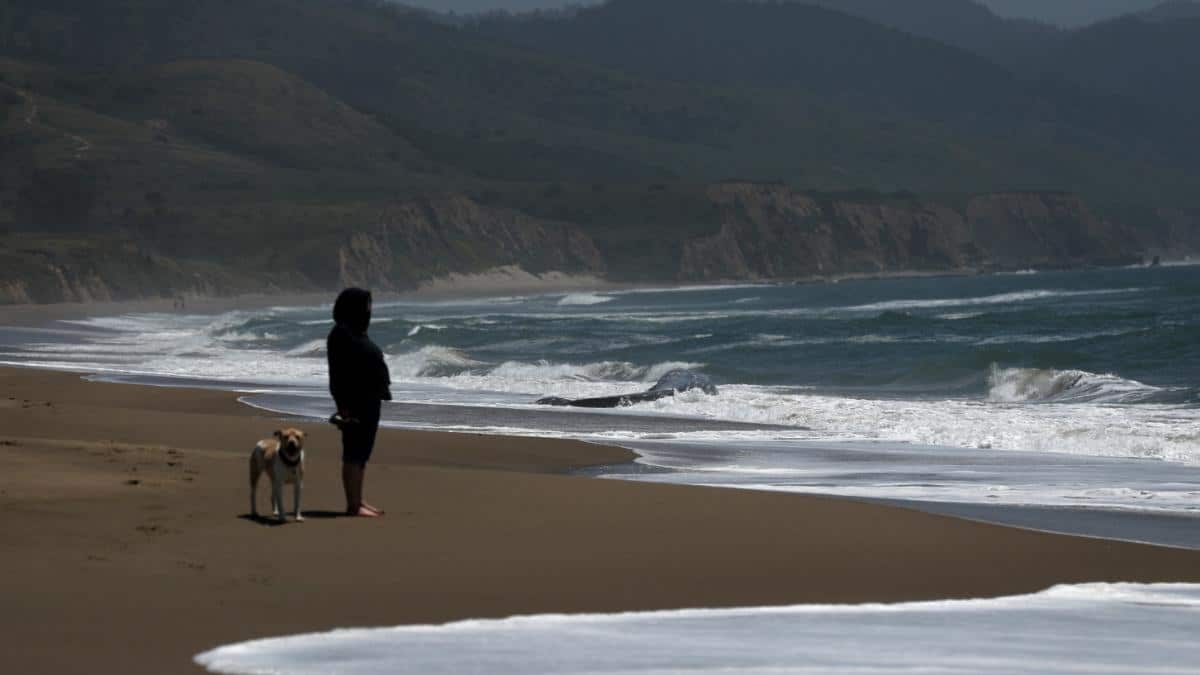

A woman looks at a dead gray whale on the beach in the SF Bay area on May 23, 2019; a new spate of gray whales have been turning up dead near San Francisco. Justin Sullivan / Getty Images
Four gray whales have washed up dead near San Francisco within nine days, and at least one cause of death has been attributed to a ship strike.
More whales than usual have been washing up dead since 2019, and the West Coast gray whale population continues to suffer from an unusual mortality event, defined by the National Oceanic and Atmospheric Administration (NOAA) as “a stranding that is unexpected; involves a significant die-off of any marine mammal population; and demands immediate response.”
“It’s alarming to respond to four dead gray whales in just over a week because it really puts into perspective the current challenges faced by this species,” Dr. Pádraig Duignan, director of pathology at the Marine Mammal Center, said in a press release.
As the world’s largest marine mammal hospital, the Sausalito-based center has been investigating the recent spate of deaths. The first involved a 41-foot female who washed up dead at San Francisco’s Crissy Field on March 31, SFGate reported. The cause of death remains a mystery, as the whale was in good condition with a full stomach. The second, another female, washed up on April 3 at Fitzgerald Marine Reserve on Moss Beach.
“That animal’s cause of death, we suspect, was ship strike,” the Marine Mammal Center’s Giancarlo Rulli told SFGate. “Our plan is to eventually head back out to that whale and take more samples.”
The third whale washed up April 7 near Berkeley Marina, The AP reported. The center determined it was a 37-foot male in average condition, with no evidence of illness or injury.
A 41-foot female turned up the next day on Marin County’s Muir Beach. She suffered bruising and hemorrhaging around the jaw and neck vertebrae, indicating a vessel strike.
Vessel strikes are one of the leading causes of death for gray whales examined by the Marine Mammal Center, along with entanglements in fishing gear and malnutrition. While the species is not endangered, the population has declined by 25 percent since last assessed in 2016, CNN reported.
West Coast gray whales travel 10,000 miles every year between Mexico and the Arctic, according to The AP. They spend the winter breeding off of Baja California, and feed along the California coast in spring and summer on their way back north. The Marine Mammal Center began noticing a problem for the migrating whales in 2019.
“Our team hasn’t responded to this number of dead gray whales in such a short span since 2019 when we performed a startling 13 necropsies in the San Francisco Bay Area,” Dr. Duignan said in the press release.
The 2019 deaths led NOAA to declare an unusual mortality event for West Coast gray whales. It is similar to another event that happened from 1999 to 2000, after which the whales’ numbers rebounded to even higher levels. This suggests population dips and rises may not be uncommon for the species. However, it is also possible that the climate crisis is playing a role. The 2019 deaths were linked to malnutrition, and warmer waters can reduce the amount of food whales have to eat in the Arctic, giving them less energy for their migration, CNN explained. Overfishing can also play a role in depriving whales of food, the Marine Mammal Center said.
Dr. Jeff Boehm, Marine Mammal Center CEO and veterinarian, told CNN that he had observed an uptick in shipping traffic after the pandemic caused a slowdown. At the same time, the center is less able to conduct research because of COVID-19 safety precautions. And even in the best of times, only around 10 percent of dead whales wash up on shore, The AP reported.
“This many dead whales in a week is shocking, especially because these animals are the tip of the iceberg,” Kristen Monsell, legal director of the Center for Biological Diversity’s Oceans program, told The AP.
- Drones Capture Stunning Footage of Humpback and Gray Whales ...
- Ninth Gray Whale in Two Months Washes Up Dead in Bay Area ...

 233k
233k  41k
41k  Subscribe
Subscribe 